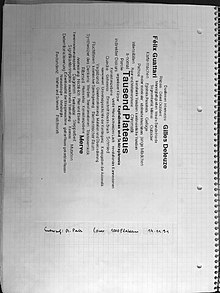Word cloud

A tag cloud (also word cloud , keyword matrix or keyword cloud rare, label cloud ; Engl. : Tag cloud , word cloud ) is a method of information visualization , in a list of keywords , often sorted alphabetically will be displayed flat, with individual differently weighted words or greater highlighted in another way. It can display two organizational dimensions (alphabetical sorting and weighting) at the same time and make them comprehensible at a glance.
Word clouds are used in collaborative indexing and weblogs . Known applications include the representation of popular keywords in Flickr , Technorati and Del.icio.us .
Tag clouds were probably first 2002 Jim Flanagan used and first as a weighted list (Engl. Weighted list ) refers. Some time earlier - in 1992 - the book “Tausend Plateaus. Capitalism and Schizophrenia ”by Gilles Deleuze and Félix Guattari , on the cover of which a“ cloud of concepts ”is already depicted.
Creation
In principle, the font size of a keyword in a keyword cloud is determined by its frequency. For a word cloud of the categories of a weblog, the frequency of use corresponds, for example, to the number of weblog entries that are assigned to a category. In the case of small frequencies, it is sufficient to specify the font size directly for each number from one to a maximum value. A normalization should be carried out for larger values . In the case of linear normalization, the weight of a descriptor is mapped on a size scale from to , where and indicate the range of values of the weights available.
- : font size to be displayed
- : maximum font size
- : minimum font size
- : Frequency of the subject subject
- : Frequency from which a keyword should be displayed
- : Frequency of the most frequent keyword
Since the number of indexed objects per keyword is usually distributed according to a power law , a logarithmic representation is useful for larger value ranges . For inflected languages like German, the words must first be lemmatized before counting, i.e. reduced to their basic form.
Software specially designed for this purpose is usually used to create keyword clouds. For example, there is software that automatically determines the keywords and their frequency from texts or websites and generates the keyword cloud. Other programs need a list of keywords and their weight in order to generate the keyword cloud.
perception
In some empirical usability tests , the perception and effect of keyword clouds were examined. It was found that keywords that have the following properties receive more attention:
- Keywords with a large font size (effect influenced by other factors, such as number of letters or neighboring keywords)
- Keywords in the middle of the keyword cloud (effect influenced by the respective layout of the keyword cloud)
- Keywords in the upper left quadrant (effect influenced by Western reading habits)
user friendliness
As part of tests with regard to user-friendliness , it has been found that less experienced users often have problems with word clouds: User tests and follow-up surveys have shown that many users do not understand keyword clouds intuitively and it is unclear to them why e.g. B. some terms are displayed larger than others.
Another shortcoming in terms of user-friendliness is perceived as the fact that the keyword clouds are not arranged at all or at best in alphabetical order. A study has shown that users would sort the clouds according to semantic associations. This means that they would group terms of the cloud that can be assigned to a common topic into subgroups.
Internet-experienced users, on the other hand, can usually handle word clouds without any problems and often see them as an enrichment of the user experience.
Web links
swell
- ↑ Jim Flanagan: Search Engine Referrals. In: Everything Burns. September 6, 2002, archived from the original on September 6, 2002 ; Retrieved May 17, 2006 .
- ^ The Spread of Weighted Lists. In: Signal vs Noise. Matthew Linderman, December 2, 2004, accessed May 17, 2006 .
- ↑ Gilles Deleuze, Felix Guattari: A thousand plateaus. Capitalism and schizophrenia . Berlin 1992, ISBN 978-3-88396-094-4 .
- ^ Ed Kohler: How to Make a Tag Cloud for Movable Type Blogs. (No longer available online.) In: technologyevangelist.com. March 8, 2006, archived from the original on April 28, 2006 ; Retrieved May 14, 2006 . Info: The archive link was inserted automatically and has not yet been checked. Please check the original and archive link according to the instructions and then remove this notice.
- ^ Jakob Voss: Collaborative thesaurus tagging the Wikipedia way . April 2006 [1]
- ↑ kentbye: Tag Cloud Font Distribution Algorithm. (No longer available online.) In: kentbye's blog. June 24, 2005, archived from the original on October 2, 2013 ; Retrieved May 17, 2004 . Info: The archive link was inserted automatically and has not yet been checked. Please check the original and archive link according to the instructions and then remove this notice.
- ↑ Wordle - Beautiful Word Clouds. Retrieved August 28, 2017 .
- ↑ Steffen Lohmann, Jürgen Ziegler, Lena Tetzlaff: Comparison of Tag Cloud Layouts: Task-Related Performance and Visual Exploration ( Memento of the original from October 7, 2009 in the Internet Archive ) Info: The archive link was inserted automatically and has not yet been checked. Please check the original and archive link according to the instructions and then remove this notice. (PDF; 521 kB), In: T. Gross et al. (Eds.): INTERACT 2009, Part I, LNCS 5726, pp. 392-404, 2009.
- ↑ Daniela Oelke, Iryna Gurevych: A Study on Human-Generated Tag Structures to Inform Tag Cloud Layout (PDF; 3450 kB), In: Proceedings of the International Working Conference on Advanced Visual Interfaces (AVI 2014), 2014.







